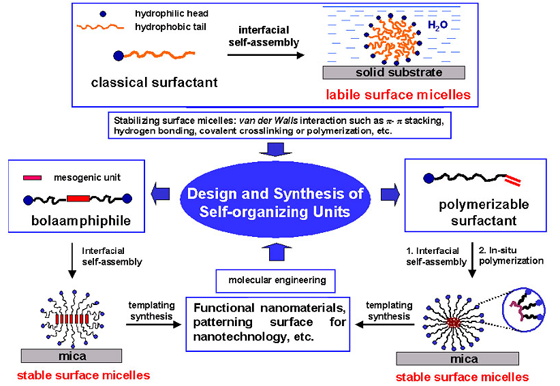 |
|
Amphiphiles can self-organize into micellar structures with defined sizes and shapes that may be used as templates for making nanostructured materials and mimicking biomineralization processes. While the micellar structures are inherently dynamic and fluidic, an engineering robustness is required to make these applications practical. To solve this problem, we have proposed different way to enhance the stability of the surface micelles either by increasing the intermolecular interaction or by polymerization in micelles, leading to development of new ways to surface patterning.
One of the molecular bases for self-assembly is amphiphilicity. It means that one can control the self-assembly in a way by tuning the amphiphilicity of the building blocks. We have used supramolecular approach and reversible chemical reactions to control the amphiphilicity, and realized molecular self-assembly as well as disassembly. For example, we have introduced photo-responsive groups into the building blocks and synthesized some supramolecular amphiphiles. An interesting finding is that these supramolecular amphiphiles can self-organize into photo-responsive aggregates exhibiting different morphologies or properties upon the UV irradiation. Based on our previous works in this area, we are invited to write a review article on Adv. Mater.(2009, 21, 2849), which covers the methods of tuning the amphiphlicity of the building blocks to control the assembly and disassembly of supramolecular systems. This line of research on the supramolecular amphiphiles which are constructed by supramolecular interactions will further broaden the application of the controllable, reversible supramolecular systems. |
|
 |
| Recent Publications: |
| J. Am. Chem. Soc. 2004, 126, 6572; J. Am. Chem. Soc. 2004, 126, 10556; Angew. Chem. Int. Ed. 2005, 44, 4731; Chem. Commun. 2006, 796; Chem. Commun. 2006, 1610; Langmuir 2006, 22, 5552; Pure Appl. Chem. 2006, 78, 1015; Angew. Chem. Int. Ed. 2007, 46, 2823; Adv. Mater. 2007, 19, 416; Chem. Mater. 2007, 19, 14; Chem. Mater. 2007, 19, 3877; Langmuir 2007, 23, 4029; Langmuir 2007, 23, 5936; J. Phys. Chem. C 2008, 112, 3308; Langmuir 2008, 24, 3734; Langmuir 2008, 24, 9233; Angew. Chem. Int. Ed. 2008, 47, 9049; Adv. Mater. 2009, 21, 2849; Langmuir 2009, 25, 8968; Langmuir 2009, 25, 10134; Chem. Commun. 2009, 5380; Polymer 2009, 50, 4821; Angew. Chem. Int. Ed. 2009, 48, 8962; Langmuir 2009, 25, 13306; Langmuir 2010, 26, 709; Chem. Sci. 2012, 3, 3227; Langmuir 2012, 28, 5023; Chem. Sci. 2013, 4, 4486; Langmuir 2013, 29, 10959; Chem. Sci. 2014, 5, 3267; Langmuir 2014, 30, 6064; Chem. Sci. 2015, 6, 4907; Acta Chim. Sinica 2016, 74, 467. |
|
| |
 |
|
|
|